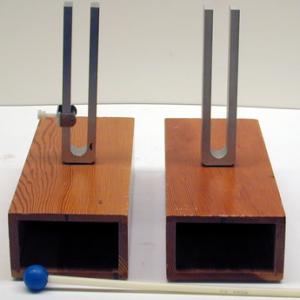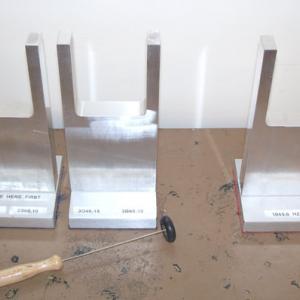College of Liberal Arts & Sciences
3B60.10 - Beats - Tuning Fork
All the tuning forks need to be coated with WD-40 at least 3 times a year to prevent rusting. To remove rust make a .1 Molar solution of Ammonium Citrate and let the metal parts soak in this for several hours. Rinse with vigorous scrubbing under running water, dry, and oil immediately. DO NOT scrape or rub the forks with any abrassive materials as this will change the pitch and vibration of the fork. Broken boxes need to be reglued with special glues to preserve their resonance properties.
Set the tuning fork side by side and strike. The beat frequency can be increased or decreased by moving the metal rider on one of the forks.
A piece of clay stuck to one tine of one of the "motor mount" style tuning forks will be enough to be able to hear a slow beat pattern.
- Panagiotis Lazos, Anastasios Nezis, Nikolaos Kyriazopoulos, "Demonstrating Mechanical Beats on Phosphorescent Foil in Real Time", TPT, Vol. 60, #3, March 2022, p. 207.
- Jochen Kuhn, Patrik Vogt, and Michael Hirth, "Analyzing the Acoustic Beat with Mobile Devices", TPT, Vol. 52, #4, Apr. 2014, p. 248.
- Frank J. Blatt, "Beats and Nodes", TPT, Vol. 32, #1, Jan. 1994, p. 5.
- Thomas B. Greenslade Jr., "Beats Produced by a Moving Tuning Fork", TPT, Vol. 31, #7, Oct. 1993, p. 443.
- Terrence P. Toepker, "More Beats", TPT, Vol. 29, #9, Dec. 1991, p. 548.
- R. G. Newburgh, "Lapping in Races as a Model for Beats", TPT, Vol. 28, #8, Nov. 1990, p. 557.
- H. J. Janssen and E. L. M. Flerackers, "Beats: An Interference Phenomenon", TPT, Vol. 17, #3. Mar. 1979, p. 188.
- Joe Crnkovich, "More on Partial Credit", TPT, Vol. 16, #2, Feb. 1978, p. 75.
- W. L. Lama, R. Jodoin, and L. Mandel, "Superradiance in Radiatively Coupled Tuning Forks", AJP, Vol. 40, #1, Jan. 1972, p. 32.
- "W-355. Tuning Fork - One Time Loaded", DICK and RAE Physics Demo Notebook, 1993.
- Julien Clinton Sprott, "3.8. Beat Frequencies", Physics Demonstrations, ISBN 0-299-21580-6, p. 163.
- David Kutliroff, "73. Resonance Demonstrations with Tuning Forks", 101 Classroom Demonstrations and Experiment For Teaching Physics, p. 160.
- David Kutliroff, "23. Beat Frequency with Tuning Forks", 101 Classroom Demonstrations and Experiments For Physics Teachers, p. 54.
- Robert Ehrlich, "8.16. Beats Using a Tuning Fork", Why Toast Lands Jelly-Side Down, p. 140.
- Robert Ehrlich, "K.3. Beats Using Two Sound Sources", Turning the World Inside Out and 174 Other Simple Physics Demonstrations, p. 144 - 145.
- Joseph Frick, "#149 - Interference of the Sound-Waves", Physical Technics: Or, Practical Instructions for Making Experiments in Physics and the Construction of Physical Apparatus with the Most Limited Means", p. 175.
Disclaimer: These demonstrations are provided only for illustrative use by persons affiliated with The University of Iowa and only under the direction of a trained instructor or physicist. The University of Iowa is not responsible for demonstrations performed by those using their own equipment or who choose to use this reference material for their own purpose. The demonstrations included here are within the public domain and can be found in materials contained in libraries, bookstores, and through electronic sources. Performing all or any portion of any of these demonstrations, with or without revisions not depicted here entails inherent risks. These risks include, without limitation, bodily injury (and possibly death), including risks to health that may be temporary or permanent and that may exacerbate a pre-existing medical condition; and property loss or damage. Anyone performing any part of these demonstrations, even with revisions, knowingly and voluntarily assumes all risks associated with them.

